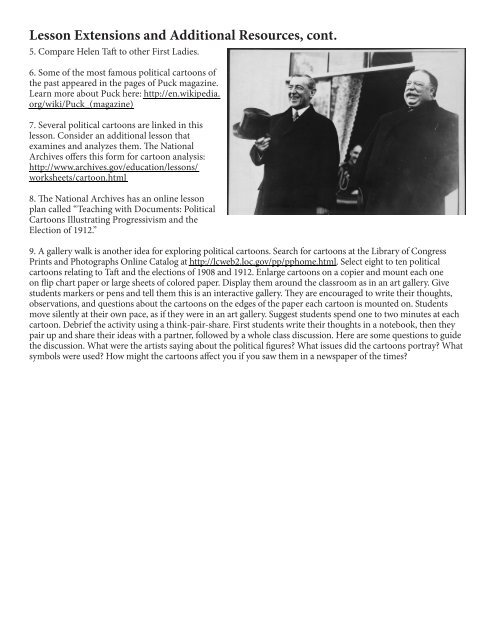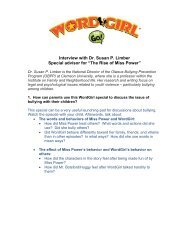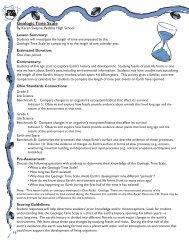Inside the Head of William Howard Taft - CET
Inside the Head of William Howard Taft - CET
Inside the Head of William Howard Taft - CET
Create successful ePaper yourself
Turn your PDF publications into a flip-book with our unique Google optimized e-Paper software.
Lesson Extensions and Additional Resources, cont.<br />
5. Compare Helen <strong>Taft</strong> to o<strong>the</strong>r First Ladies.<br />
6. Some <strong>of</strong> <strong>the</strong> most famous political cartoons <strong>of</strong><br />
<strong>the</strong> past appeared in <strong>the</strong> pages <strong>of</strong> Puck magazine.<br />
Learn more about Puck here: http://en.wikipedia.<br />
org/wiki/Puck_(magazine)<br />
7. Several political cartoons are linked in this<br />
lesson. Consider an additional lesson that<br />
examines and analyzes <strong>the</strong>m. The National<br />
Archives <strong>of</strong>fers this form for cartoon analysis:<br />
http://www.archives.gov/education/lessons/<br />
worksheets/cartoon.html<br />
8. The National Archives has an online lesson<br />
plan called “Teaching with Documents: Political<br />
Cartoons Illustrating Progressivism and <strong>the</strong><br />
Election <strong>of</strong> 1912.”<br />
9. A gallery walk is ano<strong>the</strong>r idea for exploring political cartoons. Search for cartoons at <strong>the</strong> Library <strong>of</strong> Congress<br />
Prints and Photographs Online Catalog at http://lcweb2.loc.gov/pp/pphome.html. Select eight to ten political<br />
cartoons relating to <strong>Taft</strong> and <strong>the</strong> elections <strong>of</strong> 1908 and 1912. Enlarge cartoons on a copier and mount each one<br />
on flip chart paper or large sheets <strong>of</strong> colored paper. Display <strong>the</strong>m around <strong>the</strong> classroom as in an art gallery. Give<br />
students markers or pens and tell <strong>the</strong>m this is an interactive gallery. They are encouraged to write <strong>the</strong>ir thoughts,<br />
observations, and questions about <strong>the</strong> cartoons on <strong>the</strong> edges <strong>of</strong> <strong>the</strong> paper each cartoon is mounted on. Students<br />
move silently at <strong>the</strong>ir own pace, as if <strong>the</strong>y were in an art gallery. Suggest students spend one to two minutes at each<br />
cartoon. Debrief <strong>the</strong> activity using a think-pair-share. First students write <strong>the</strong>ir thoughts in a notebook, <strong>the</strong>n <strong>the</strong>y<br />
pair up and share <strong>the</strong>ir ideas with a partner, followed by a whole class discussion. Here are some questions to guide<br />
<strong>the</strong> discussion. What were <strong>the</strong> artists saying about <strong>the</strong> political figures? What issues did <strong>the</strong> cartoons portray? What<br />
symbols were used? How might <strong>the</strong> cartoons affect you if you saw <strong>the</strong>m in a newspaper <strong>of</strong> <strong>the</strong> times?




